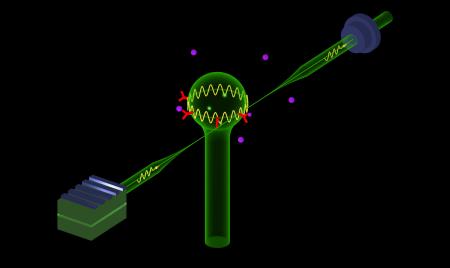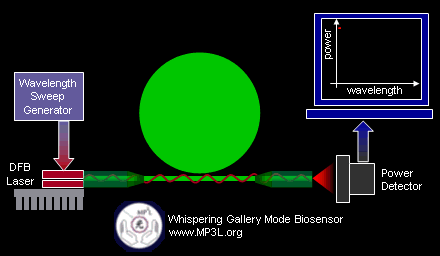Did you hear? Physics and virology collide in a Rogers Hall laboratory
 |
Stephen Arnold, director of Polytechnic Institute of NYU’s Microparticle Photophysics Laboratory for BioPhotonics (MP3L) has been quietly making strides in “whispering gallery modes (WGM)” since before optical physicists adopted the term. Talk of his research may soon get a little louder.
In its July issue, the journal Nature Methods published “Whispering-gallery-mode biosensing: label-free detection down to single molecules,” an article Professor Arnold co-wrote with Dr. Frank Vollmer of Harvard University’s Rowland Institute. The article, which can be accessed on the MP3L web site, provides a perspective on a method for detecting viruses and other infectious agents in real-time. Professor Arnold discussed his method last summer at the Faraday Discussions of the British Royal Society.
Instant detection of a viral or toxic infection is a perennial healthcare need — and a yet-to-be realized clinical dream — that is increasingly important in an age faced with the threat of pandemics and bioterrorism.
 |
| A look at Professor Arnold's whispering gallery mode biosensor in action. |
Optical tuning forks and whispering galleries
Professor Arnold uses the analogy of dust falling on a ringing tuning fork to explain how his biosensor prototype works. If you hold a ringing tuning fork in the air and dust particles fall on it, its tone (acoustic frequency) will decrease. Of course you’d have to have superhero powers to hear the change in tone caused by a piece of dust, or by an even smaller particle like a single virus only atto-grams in mass (~10-18 gm).
Professor Arnold’s device works like the most sophisticated of superhero gadgets. It uses light instead of sound to create what some have called an “optical tuning fork.” Instead of detecting changes in tone caused by dust, the device detects and measures shifts in optical frequencies caused by viruses passing through an optical “whispering gallery mode.”
The first step in understanding whispering gallery modes is a fun one that unlike hearing a virus falling on a ringing tuning fork requires no great feats of perception, but is still pretty amazing.
Whispering gallery modes, as the name implies, were born as an acoustic phenomenon. Take a friend to Grand Central Terminal and have him stand facing one of the arches in the domed exterior of the Oyster Bar & Restaurant which is known as a whispering gallery. Go to the arch directly across from your friend and whisper into the corner. Your friend will hear your whispered message as if you were standing right next to him, even though you’re standing forty feet away.
St. Paul’s Cathedral in London and Statuary Hall in the United States Capitol are also acoustic whispering galleries. Physicists adopted the term to describe the way light in a microscopic droplet of glass, plastic or liquid can become trapped by total internal reflection and travel a stable trajectory, a polygon, for example, around the droplet’s circumference. You’ve likely experienced total internal reflection in a swimming pool if you’ve looked to the water’s surface at a glancing angle while submerged and saw that the surface looked like a mirror. Total internal reflection is also the principle that makes fiber optic communication possible.
Measuring micro-nanometer shifts of a light’s wavelength
Like the sound in a whispering gallery traveling up the curve of a dome and back down to the other side, light in a circular optical whispering gallery mode travels along the inside perimeter of a much smaller glass sphere only millionths of a meter in diameter. As a wave, if it is driven at just the right frequency so that it returns in perfect phase, i.e., back to its starting point, after each revolution, the energy in the interior builds up to a crescendo known as resonance. This occurs over such a narrow frequency range that ultra-small changes in the light’s path can cause the frequency of the resonance to undergo a shift.
A single virus binding to the surface of the sphere causes a micro-nanometer (femtometer) change in the orbiting wavelength. Surprisingly this small shift can be measured, enabling the whispering gallery mode biosensor to detect a virus without chemical labels. The use of chemical labels is currently the prevailing technique to detect viral infection. By eliminating chemical labels, Professor Arnold’s biosensor can work in real-time.
Additionally, the shift’s measurement can be used to determine the size and mass of the virus. Iwao Teraoka, associate professor of chemistry and co-director of the MP3L, has been extending the theory for this phenomenon and looking at new geometries that can lead to further enhancements of the whispering gallery mode biosensor.
Where it all began
Before they were called whispering gallery modes, Professor Arnold and others in his field were calling them photonic-atom modes, a term he coined in the 1980s. At the time he was researching the energy transfer between neighboring molecules in aerosol particles with a graduate student, Lorcan Folan, who is now chair of NYU-Poly’s Physics Department.
Instead of observing a change in short-range transfer, they found that the molecules could “whisper” to one another over an unprecedented long range. Reflecting on his inability to see enhanced short-range energy transfer he wrote this in a 2001 American Scientist article: “I take great pleasure in remembering the experiments of [the] 1980s that led me into the field of microsphere photonics in the first place…In that quest [to find enhanced short-range energy transfer] I failed, which I realize now was the best thing I could have hoped for.”
Professor Arnold decided to apply his work to microsphere photonics and focus his lab’s attention on creating a method of rapid virus detection to honor the memory of one of his friends who died from a viral infection that doctors caught too late.
Where it is now and how far it could go
Professor Arnold’s prototype experiments have shown great potential. Continued research, funding and time will take his biosensor out of the lab and into the hands of doctors and clinicians.
The U.S. Army Corps of Engineers is already interested in using his technology to detect water contamination. Dr. Stephen Holler, director of research and development and partner at NovaWave Technologies, is leading this effort. He has collaborated extensively with Professor Arnold in the past and was a member of the MP3L as an undergraduate before leaving for graduate studies at Yale University in the mid-1990s. NovaWave is one of NYU-Poly’s BEST business incubator companies; it also has offices and laboratories at its west coast center in Redwood City, California.
Not too surprisingly, the MicroParticle PhotoPhysics Lab’s research groups include physics, biomedical engineering, electrical engineering and biochemistry students. David Keng, a graduate biomedical engineering student and member of the MP3L, has co-authored several research papers with Professor Arnold and continues to work with him to refine the biosensor prototype.
One of the most innovative ideas for how far the technology can go is miniature biosensors enclosed in organic mater, like an empty red blood cell, that are injected into the body. As it travels the cardiovascular system, the biosensor would search for toxins or disease markers, sending a signal to a physician at the instance of infection miles and miles away from a hospital.




